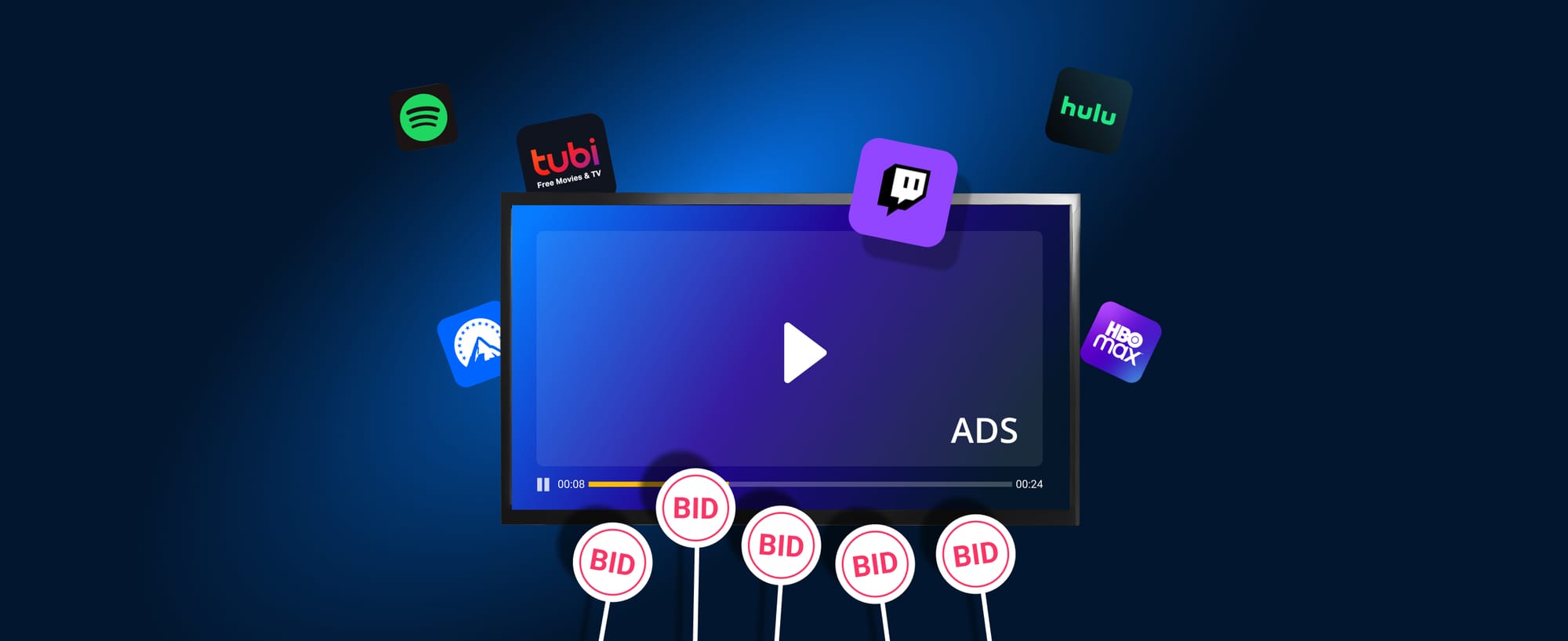Header bidding is a digital advertising technique where app publishers present their ad inventories to multiple ad exchanges and ad networks simultaneously. It’s extremely popular in the mobile and connected TV (CTV) ad markets since it provides a more efficient and competitive method for publishers to monetize their apps.
In this article, we delve into the intricacies of header bidding, covering its application across mobile and CTV platforms. We also discuss header bidding SDKs and how to discover which apps implement them for their own real-time bidding (RTB) auctions.
Here’s what we cover (click the links to jump to the corresponding section):
- What Is Header Bidding?
- How Does Header Bidding Work?
- What Is Header Bidding for Mobile and CTV Advertising?
- What Are Header Bidding SDKs?
- How to Find Apps That Use Header Bidding SDKs
Looking for apps that use header bidding SDKs? Let’s chat!
What Is Header Bidding?
As noted above, header bidding is an advanced programmatic advertising technique that allows publishers to offer their ad inventory to multiple ad exchanges simultaneously before making calls to their ad servers. It is an alternative to the traditional ‘waterfall’ technique, where ad inventory is offered to bidders in sequential order, based on predetermined hierarchies or priorities.
The main objective of header bidding is to increase competition for ad inventory in the pursuit of higher revenues for publishers.
The primary goals of header bidding include:
- Increased Revenue: By allowing multiple demand sources to bid on the inventory at the same time, publishers can achieve higher fill rates and potentially higher ad revenues.
- Fairer Competition: Unlike the traditional waterfall method, where demand sources are prioritized, header bidding levels the playing field by letting all demand sources bid at the same time.
- Transparency: Publishers gain insight into the true value of their inventory, as they can see how much each ad impression is worth across different demand sources.
How Does Header Bidding Work?
There are five steps to header bidding: Integration, Ad Requests, Bids, Winner Selection, and Ad Display. Let’s handle these one by one!
STEP 1: Integration
In traditional web-based header bidding environments, publishers integrate what’s called a header bidding script or header bidding wrapper into the header section of their websites. This is a framework or set of code (commonly JavaScript) that manages and streamlines the header bidding process for publishers, enabling their sites to conduct auctions for ad slots across multiple demand sources before the content of the page is fully loaded.
However, since there are no HTML headers in mobile and CTV apps, this concept is adapted slightly when it comes to placing ads in those environments. Rather than a header bidding script, app publishers integrate software development kits (SDKs), like Prebid Mobile, MoPub, and IronSource, or application programming interfaces (APIs) into their apps. These then replicate the function of traditional header bidding.
STEP 2: Ad Requests
When a user accesses a web page or launches a mobile app, the header bidding technology (whether implemented through a script or an SDK) initiates simultaneous ad requests to various demand sources or ad exchanges. This concurrent bidding approach contrasts with the waterfall method, where ad sources are queried in a sequence.
STEP 3: Bids
Once these ad requests have been extended, various demand sources then participate in an auction by sending their bids for the ad inventory in real-time.
STEP 4: Winner Selection
The highest bidder wins the right to display their ad on the publisher's ad space. This decision, which is near instantaneous, is often made by the header bidding wrapper or technology that manages the auction.
STEP 5: Ad Display
The winning bid is passed to the publisher’s ad server, which then displays the winning ad on the website or app.
What Is Header Bidding for Mobile and CTV Advertising?
As noted in the previous section, header bidding works a little differently in the mobile and CTV space, extending the basic principles beyond web environments and adapting them to the unique ecosystems of mobile applications and CTV platforms. This adaptation allows for more competitive and transparent ad auctions, leading to increased ad revenues for app developers and publishers in these spaces.
So, briefly, let’s take a closer look at these particular examples, as well as some key considerations when it comes to implementing header bidding in this space…
Header Bidding for Mobile Apps
In the context of mobile apps, header bidding involves using SDKs or APIs to facilitate RTB auctions directly within the app environment. Unlike web-based header bidding, which entails adding specific pieces of JavaScript code (i.e. header bidding wrappers or header bidding scripts) in the webpage header, mobile apps require these integrated solutions to manage the auction process because apps don't operate within a browser environment. This setup allows multiple demand partners to bid on ad inventory simultaneously, before making the call to the ad server, similar to web-based header bidding.
Header Bidding for CTV Apps
CTV apps run on smart TVs, streaming devices like Roku or Fire TV, and gaming consoles. Header bidding in CTV involves a similar process to that in mobile apps, where a server-side solution typically handles the auction. Due to the nature of CTV devices and their limited processing power compared to traditional computers, header bidding in CTV is often managed server-side to minimize the load on the device itself. This approach ensures that the user experience remains smooth, without the latency that can come from running complex auctions on the device.
Key Considerations for Mobile and CTV Header Bidding
- SDK Integration: For mobile and CTV apps, header bidding typically requires integrating an SDK provided by the ad tech partner, which can add complexity to the app development and maintenance process.
- Latency: Minimizing latency is crucial, especially for CTV apps, to ensure that user experience is not degraded. Server-side auctions are one way to address this challenge.
- Fragmented Ecosystem: The CTV ecosystem is quite fragmented with different devices and operating systems, which can complicate the implementation of a unified header bidding solution.
- Ad Experience: Maintaining a high-quality ad experience is critical, especially on CTV, where viewers have high expectations for content and ad quality similar to traditional TV.
Want to learn about data enrichment for optimized mobile and CTV ads? Read more!
What Are Header Bidding SDKs?
Alright, let’s get a little more granular. Header bidding SDKs are comprehensive toolsets designed to enable mobile and CTV publishers to seamlessly implement header bidding capabilities into their apps. These SDKs facilitate RTB from multiple demand sources directly in-app, rather than relying on traditional ad servers or waterfall bidding processes.
Key Components and Features of Header Bidding SDKs:
- Auction Mechanism: This is the core functionality where the SDK manages the process of soliciting bids from various demand partners for each ad opportunity in real-time.
- Demand Partner Integration: SDKs typically come with pre-built integrations for multiple demand sources, making it easier for publishers to connect with various ad networks, ad exchanges, and Demand-Side Platforms (DSPs).
- Ad Rendering: Once the winning bid is accepted, the SDK handles the rendering of the ad within the app, ensuring that the ad displays correctly and tracks user interactions.
- Latency Optimization: Given the importance of user experience, especially in mobile and CTV streaming environments, header bidding SDKs often include features to minimize latency, such as asynchronous bidding and ad preloading.
- Analytics and Reporting: Publishers can access detailed analytics and reporting features to monitor auction performance, bid responses, fill rates, and revenue, allowing for data-driven optimization.
- Compliance and Privacy: With growing concerns around user privacy and data protection, SDKs are designed to be compliant with regulations such as GDPR and CCPA, providing mechanisms for consent management and data privacy.
CHECK IT OUT: Top Header Bidding SDKs for Mobile Advertising
- Facebook Audience Network — 392,121 Integrations
- Amazon Ads - Transparent Ad Marketplace — 30,895 Integrations
- Criteo Publisher — 12,427 Integrations
- PubMatic OpenWrap - OpenBid — 1,854 Integrations
How to Find Apps That Use Header Bidding SDKs
The 42matters SDK Explorer is an app market research tool that allows you to explore and analyze 2,600+ iOS and Android SDKs used by millions of apps across the Apple App Store and Google Play. This includes ad exchange and ad network SDKs used for header bidding. Here’s what it looks like:

To find apps that use specific header bidding SDKs, do the following:
STEP 1: Launch the SDK Explorer
First, navigate to 42matters.com and launch the SDK Explorer from the launchpad. If you don’t have an account with 42matters, you can sign up for a 14-day free trial here.
STEP 2: Search for Header Bidding SDKs
Once in the SDK Explorer, you can search for specific header bidding SDKs by name. Depending on where your business sits in the industry, you can look up your competitors, ad partners, etc.
Popular names in the industry include Prebid, MoPub by AppLovin, etc. If you're not sure about the exact names, you might need to do some preliminary research on popular header bidding SDKs in the market.

STEP 3: Analyze the List
Once you’ve found the SDKs of interest, you can browse the apps that use them. By clicking the “Open Explorer to view all apps” button, you can access the SDK’s entire user base in the Explorer platform, which is similar to the SDK Explorer but focused on app intelligence rather than SDKs.

STEP 4: Dive Deeper into Specific Apps
If you're interested in a particular app, you can click on it to get more detailed information. This includes app and publisher details like metadata, integrated SDKs, ad sellers (app-ads.txt), bundle IDs, store IDs, categories, IAB categories, parental advisories, content ratings, performance metrics (downloads, MAUs, etc), and much, much, more.

STEP 5: Export Data
Finally, you can export the SDKs’ app user base into a CSV file for data enrichment, lead generation, CRM integration — anything!
Other Articles You Might Find Interesting…
If you’d like to learn a little more about 42matters’ app intelligence solutions and how they can be deployed by AdTech companies across the mobile and CTV market, we recommend checking out these articles:
- How to Get App Publisher Leads for SDKs, Ad Networks, etc.
- SDK Competitor Analysis: Find Apps that Use Competitor SDKs
- Roku Advertising: Grow Your Roku TV Advertising Inventory
- Data Enrichment for Mobile and CTV AdTech Companies
And, if you have any further questions, feel free to reach out to our team directly!



